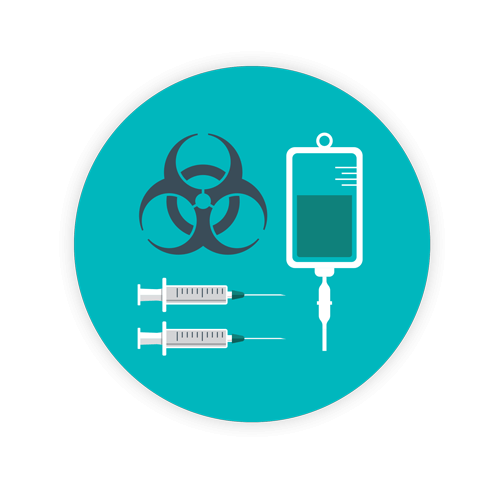Guide to New York Medical Waste Regulations

This topic isn’t nearly as exciting as New York itself is, but if you’re in the healthcare industry and work in the state, it’s important to ask yourself: do you know what to do with your medical waste? Are you familiar enough with New York medical waste regulations to avoid fines, penalties, or potential jail time? They call New York the “state of opportunity,” will you take this opportunity to make sure you’re acting compliantly when it comes to hazardous waste disposal?
Consider the following: do you know the regulations regarding biohazard waste? What about microbiological waste? Surgical waste? Proper waste segregation is essential in today’s healthcare environment. Federal and state regulations combined provide detailed information regarding how medical waste is to be disposed of in New York. Daniels Health can help you understand the regulations for your state.
How does New York define medical waste?
Be aware that there’s a difference between regulated and nonregulated medical waste. Daniel’s Health is aware of those differences. We’re experienced in helping guide waste generators, large or small, through the minefield of federal and state guidelines that cover everything from chemo waste to pathological waste and pharmaceutical waste disposal.
In New York, the Department of Environmental Conservation (DEC) defines regulated medical waste as any type of material that is generated through biological testing, research, and healthcare scenarios. That includes:
- Needles and syringes (otherwise known as sharps) – by the way, do you utilize approved sharps container placement? What about your sharps removal service? Are they following the rules? You’re the responsible party for your waste, make sure you choose your partners well.
- Human blood and blood products
- Infectious animal waste
- Human pathological waste
- Microbiological waste materials such as cultures
- any other type of biohazard waste, such as those that may be contaminated with infectious agents
Do you know where your facility falls under New York’s guidelines in regard to healthcare waste segregation, healthcare waste management, or medical waste removal? In the state of New York, a number of facilities fall under these guidelines, such as (but not limited to):
- hospitals
- funeral homes
- clinical laboratories
- physicians’ offices
- pharmaceutical companies
- correctional facilities
- nursing homes
- home health providers
Ensure that you’re following guidelines as specified by the New York’s DEC in addition to other agencies involved in the regulation and management of medical waste, such as the:
- Environmental Protection Agency (EPA)
- Department of Transportation (DOT)

What about household medical waste, such as sharps? As a healthcare provider, you should be able to advise your patients on the rules. The DEC provides specific guidelines regarding disposal of household sharps to protect trash handlers, sewage treatment workers, as well as the public in general, from accidental exposure to needlestick injury and other container related sharps injuries. It’s important for everyone to work together to keep our environment clean and safe from sharps.
Note – Unlike medical facilities, the state of New York does allow household sharps to be disposed of with household trash, although local laws may prohibit such disposal. Regardless, a sharps container should never be placed with recyclable items. Do your research!
In New York State, the regulation of medical waste is under the purview of the New York state’s Department of Health (DOH), as well as the Wadsworth Center and the Department of Environmental Conservation (DEC). So many acronyms, oy.
What about biohazard waste regulations in New York? Did you know that the waste generator is responsible for the proper storage, collection, and labeling of regulated medical waste for off-site transportation? Do you know that you’re supposed to complete the medical waste tracking form, in addition to additional requirements deemed necessary by local health departments? These are questions you must ask yourself if you wish to avoid fines.
In New York, details regarding disposal of medical waste is found on the website of the DEC under Title 15, Article 27, Chapter 431.
Not only that, but OSHA regulations also apply in regard to health of public sector employees and workplace safety. Guidelines for the Occupational Exposure to Bloodborne Pathogen Standard is applicable in all scenarios, as is handling or exposure to sharps, medical waste of any kind, in addition to employee training for the handling of potentially hazardous or contaminated materials can pose a risk to health care workers.
In New York, federal laws and regulations for regulated medical waste fall under the federal guidelines of the Medical Waste Tracking Act. Federal rules in this state mainly focus on “packaging” for interstate transportation of medical waste, as well as handling of blood-borne pathogens. Daniels health can offer guidance on proper packaging and provide safe transportation. A number of other federal laws are also applicable to the handling, collection, transportation, and disposal of certain regulated medical waste streams. Agencies or regulations involved in these areas include:
- Resource Conservation and Recovery Act
- The Comprehensive Environmental Response, Compensation, and Liability Act
- The Clean Air Act
- US Postal Service
- US Department of Agriculture
- US Public Health Service
- Food and Drug Administration (FDA)
The devil is in the details. Every state stipulates their own guidelines regarding sharps container placement, and regulations for sharps injury reduction, and sharps removal service options. Know the details—or work with someone at Daniels Health who does.
Do you know where to find guidelines and policies in regard to hazardous waste?
New York state’s guidelines are thorough and detailed. Actually, New York leaves no room for doubt in regards to medical waste generators when it comes to guidelines for dealing with numerous types of medical waste that ensure compliance with federal and state guidelines and requirements.
A number of updates and changes were slated for hazardous waste regulations in 2018. State regulations can be found under revisions of hazardous waste management (6 NYCRR part 370 series).
However, the applicable federal EPA regulations are found under 40 Code of Federal Regulations (CFR) and may also be referred to for the same topics. For example (and this does not include all of the current and equivalent federal hazardous waste management regulations):
| State Regulation (6 NYCRR) | EPA regulation Code of Federal Regulations (40 CFR) | Description |
|---|---|---|
| Part 370 | Part 260 | Hazardous waste management system: general |
| Part 371 | Part 261 | Identification and listing of hazardous waste |
| Part 372 | Part 262 | Standards applicable to generators of hazardous waste |
| Subpart 374-1 | Part 266 | Standards for the management of specific hazardous wastes and specific types of hazardous waste management facilities |
| Part 376 | Part 268 | Land disposal restrictions and treatment standards |
Yes, New York medical waste regulations, guidelines, and rulings are extensive, but they cover numerous scenarios, facilities, and both large and small waste generators. Ignorance is no excuse not to follow these clearly-detailed regulations. The experts and Daniels Health are happy to help you read the fine print and provide your site with compliant solutions.
Daniels Health does the research so you reap the benefits
Adherence to federal and state regulations and guidelines when it comes to healthcare waste segregation, management, and disposal is essential in today’s environment. Daniels Health provides solutions for the disposal of numerous types of medical waste as well as sharps disposal, reusable containers, and methods to not only reduce the volume of medical waste heading to landfills, but on goals for reduced carbon footprint and CO2 emissions reduction. Stay compliant. Avoid fines and penalties. Call Daniels Health for options in the latest in medical waste innovations, safety, and sustainability.
If you would like further help navigating New York’s medical waste regulations, call one of our clinical experts today! Alternatively find out more about our New York operations and service capabilities on our New York service page here.
Let's Talk!
Your time is valuable, and we don’t want to play hard to get. You can either phone us directly on the details listed on our contact page, or feel free to fill out this short form and one of our team members will get back to you as quickly as possible.
